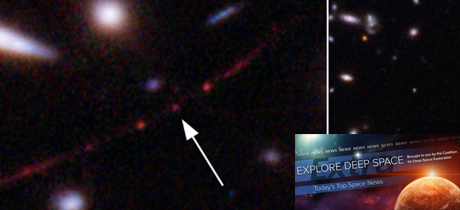In Today’s Deep Space Extra… Northrop Grumman assessing options for future HLS development and Cygnus flights. The return to Earth of a NASA astronaut and two cosmonauts aboard a Russian spacecraft ends on cooperative note despite global tensions. The Hubble Space Telescope spots the most distant star yet.
Human Space Exploration
Northrop Grumman weighing options for new Artemis lunar lander competition
Coalition Members in the News – Lockheed Martin, Northrop Grumman, United Launch Alliance and Coalition Board Member in the News – Lisa Callahan
SpaceNews.com (3/31): According to a Northrop Grumman representative during a briefing yesterday, the company is assessing options for responding to NASA’s March 23 Sustaining Lunar Development announcement, which seeks proposals from the private sector for a second lunar Human Landing System (HLS). During the first HLS competition, Northrop Grumman was part of a team led by Blue Origin, which also included Lockheed Martin. Northrop could rejoin Blue Origin for the Sustaining Lunar Development competition or compete on its own. Last year, Lockheed Martin offered a similar perspective: “As a long-standing and trusted NASA partner, we also believe it is important to provide additional approaches to help shape the strategy for both a sustainable human presence on the Moon and also future human missions to Mars,” Lisa Callahan, vice president and general manager of commercial civil space at the company, said. About the Antares rocket, which uses a first stage produced in Ukraine and powered by a Russian RD-181 engine, and which Northrop Grumman uses to launch Cygnus cargo spacecraft to the International Space Station (ISS), Northrop representatives confirmed at the briefing that the company has the hardware needed for the next two missions, and that otherwise, since Cygnus is designed to be compatible with a range of launch vehicles, the company continues to review options to provide future missions.
On the Space Station, U.S. and Russian astronauts steer around the war in Ukraine
Global Online Money (3/30): NASA astronaut Mark Vande Hei’s return to Earth early Wednesday aboard a Russian Soyuz spacecraft with two cosmonauts after a U.S. record-setting 355 days in space seemed to demonstrate a desire by the space agencies of the two countries to work cooperatively despite the global tension over Russia’s military incursion into Ukraine. As planned, Russia’s Soyuz MS-19 space capsule descended safely to Earth in Kazakhstan early Wednesday, returning Vande Hei and cosmonauts Anton Shkaplerov and Pyotr Dubrov.
TIME100 most influential companies of 2022
Coalition Member in the News – Axiom Space
Time.com (3/30): Axiom Space is preparing to launch a private astronaut mission to the International Space Station (ISS) in April and has deals with NASA to build new ISS modules, with the first launching as early as 2024. Before the ISS is retired in 2030, Axiom plans to separate the modules, becoming their own private station. Axiom was chosen as one of TIME’s most influential companies of 2022. “Which businesses and corporate leaders are shaping our future?” is the question at the heart of TIME100 Most Influential Companies, an annual list that highlights businesses making an impact.
Space Science
A new record! Hubble detects an individual star from a time when the universe was less than a billion years old
Universetoday.com (3/30): Imagery from the Hubble Space Telescope mission has identified the most distant star yet observed. The star, nicknamed Earendel, is 50 times brighter than our sun and estimated to have formed when the universe was but 900 million years old. Details of the discovery were provided by a Johns Hopkins University-led study effort published in the journal Nature. Astronomers expect that Earendel will remain highly magnified for years to come. It will be observed by the James Webb Space Telescope (JWST). JWST’s high sensitivity to infrared light is needed to learn more about Earendel because its light is stretched (redshifted) to longer infrared wavelengths due to the universe’s expansion.
China to launch Einstein Probe in 2023 to observe violent cosmic events
SpaceNews.com (3/30): China’s wide-field x-ray space observatory has passed a major review and is expected to launch next year to detect flashes from high energy cataclysmic events. China’s Einstein Probe mission is planned for launch in mid-2023 to observe distant, violent interactions. Those could include disruption events in which stars are pulled apart by supermassive black holes.
Other News
Paso Robles Spaceport moving forward as city teams up with Cal Poly, spaceplane builder
Sanluisobispo.com of California (3/30): Paso Robles city officials are proceeding with plans to establish a horizontal spaceport at the town’s municipal airport in cooperation with the California Polytechnic State University and Wagner Star Industries to help diversify the local economy.

